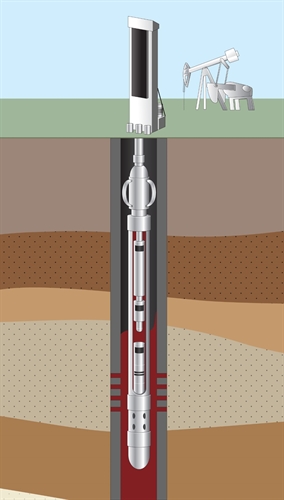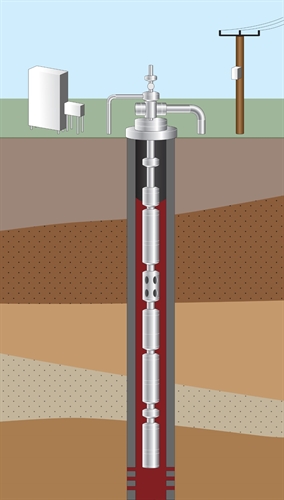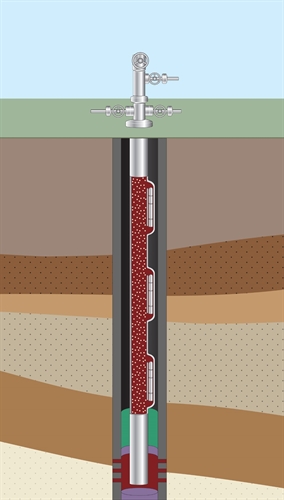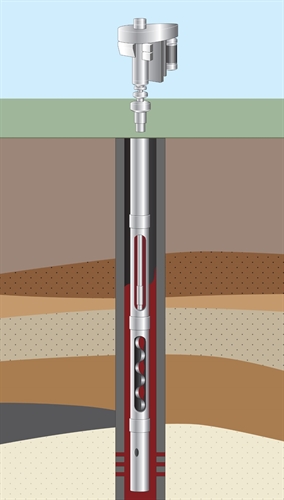Replacing Other Artificial Lift Technologies | Head-to-Head Comparison
- Lower Life Time Costs.
- No Moving Parts Down Hole.
- Optimise Production.
- Controllable. Efficient. Reliable.

No Workover Rig Required

Save* $11,000+ per month, per well!
Compare the Benefits of Jet Pumps to Other Technologies
- vs. Reciprocating Rod Lift (RRL)
- vs. Electric Submersible Pumps (ESP)
- vs. Gas Lift
- vs. Progressive Cavity Pumps (PCP)
Reciprocating Rod Lift (RRL)

Case Study
Jet Pump reduces annual workover cost of a deviated beam pumping Frio well while increasing oil production and profitability
Benefits of Jet Pumps - Compared to Reciprocating Rod Lift (RRL)
Lower Lifetime Costs
Capital Costs
A jet pump system can be installed at a greatly reduced cost of a rod pump and down hole equipment.
Operating Costs
Lower power usage costs are achieved from the surface unit due to increase in jet pump efficiency. Operating Efficiency Jet pumps have the best overall total process efficiency, in Horse Power (HP) per barrel produced. Achieved through a combination of the Jet pump’s design increasing critical flow areas to increase efficiency dramatically and the 90% efficient Hydra-Cell power fluid pump.
Down Hole Equipment
Jet pumps have no moving parts in the pump resulting in a long service life. Simple repair procedures is all that is needed to run and retrieve pump down hole.
Optimise Production
Reservoir Access
Jet pump’s excellent design allows for full bore access to the reservoir and is very easy to run any type of surveillance.
Number of Wells
From single to multiple wells operating from one single, seal-less and packing-free surface hydraulic package greatly reduces lift cost with jet pumps.
Well Intervention
Jet pumps do not need a workover or pulling rig. Jet pumps can be easily circulated to the surface without pulling the tubing or it can be retrieved by wireline. Flexible optimisation of production by simple changes to injection power fluid flow rate and pressure, mixing tube and nozzle combinations. Especially with changing well conditions.
Designed for Flexibility and Reliability
Well Inclination
Jet pumps are excellently suited to vertical and deviated completion up to 70˚. Rod pumps are not suited to deviated wells.
Depth Limit
Not restricted with jet pumps with a practical depth to 20,000 ft. For less than 2,500 ft, rod pump must be landed below the dynamic fluid level.
Tubing and Casing Range
Great flexibility is available and no limitations with the jet pumps range of tubing sizes from 23/8” to 4½”.
Sand and Solids Handling Ability
High solids and sand production can be problematic to rod lift for low oil viscosity (<10 cp). Excellent reliability is assured with jet pumps due to increased flow areas, robust parts, special metallurgy and coatings.
Electric Submersible Pumps (ESP)

Case Study
Jet Pump replaces ESP and greatly reduces workover cost while continually chemically treating wellbore.
Benefits of Jet Pumps - Compared to Electric Submersible Pumps (ESP)
Lower Lifetime Costs
Capital Costs
A jet pump system can be installed at greatly reduced costs compared to ESPs, even with high horsepower systems. A jet pump is small in size and easily handled without any handling equipment and fits readily with any completion profiles and fittings.
The power fluid injection units can be operated by natural gas, diesel or electric powered drivers.
Operating Costs
Lower power usage costs are achieved from the surface unit due to increase in jet pump efficiency compared to costly interventions to change out conventional ESP completion.
Operating Efficiency
Jet pumps have the best overall total process efficiency, in Horse Power (HP) per barrel produced. Achieved through a combination of the Jet pump’s design increasing critical flow areas to increase efficiency dramatically and the 90% efficient Hydra-Cell power fluid pump.
Down Hole Equipment
Jet pumps have no moving parts in the pump resulting in a long service life, no run dry issues. Simple repair procedures is all that is needed to run and retrieve pump downhole. No cable or additional motors, seals, etc. needed.
Optimise Production
Reservoir Access
Jet pump’s excellent design allows for full bore access to the reservoir. There is no limitations to access and no workover is required for any remedial work. No run dry issues.
Number of Wells
From single to multiple wells operating from one single surface hydraulic package greatly reduces lift cost with jet pumps.
Well Intervention
Jet pumps do not need a workover or pulling rig. Jet pumps can be easily circulated to the surface without pulling the tubing or it can be retrieved by wireline. This ensures easy maintenance and a longer service life; no change out of total completion needed.
Flexible optimisation of production by simple changes to injection power fluid flow and pressure, mixing tube and nozzle combinations. Especially with changing well conditions.
Designed for Flexibility and Reliability
Well Inclination
Jet pumps are excellently suited to vertical and deviated completion. No need for long radius wellbore bends to get through. Poor drilling issues, such as “dog-leg” or “crooked” drilling, are easily overcome.
Depth Limit
No restrictions with jet pumps with a practical depth to 20,000 ft. This is neither limited by motor horsepower or temperature for ESP.
Tubing and Casing Range
Great flexibility is available and no limitations with the jet pumps range of tubing sizes from 23/8” to 4½”.
Sand and Solids Handling Ability
ESP is poor for sand and solids handling as it requires <100 parts per million (ppm) solids. Sands at this concentration is normal wear and tear for an ESP. Not recommended for greater than 100 ppm, due to friction and wear on ESP equipment. Excellent reliability is assured with jet pumps due to increased flow areas, robust parts and special metallurgy and coatings.
Gas Lift

Case Study
Jet pump greatly increases oil and gas production using less energy and eliminating the need for costly make up gas.
Benefits of Jet Pumps - Compared to Gas Lift
Lower Lifetime Costs
Capital Costs
A jet pump system can be installed at greatly reduced costs compared to Gas Lift systems with no compression costs or gas distribution systems needed.
Operating Costs
Lower power usage costs are achieved from the surface unit due to increase in jet pump efficiency compared to costly interventions to change out Gas Lift System.
Operating Efficiency
Jet pumps have the best overall total process efficiency, in Horse Power (HP) per barrel produced. Achieved through a combination of the Jet pump’s design increasing critical flow areas to increase efficiency dramatically and the 90% efficient Hydra-Cell power fluid pump.
Down Hole Equipment
Jet pumps have no moving parts in the pump resulting in a long service life, no run dry issues. Simple repair procedures is all that is needed to run and retrieve pump downhole.
Optimise Production
Reservoir Access
Jet pump’s excellent design allows for full bore access to the reservoir. There is no limitations to access and no workover is required for any remedial work. No run dry issues.
Number of Wells
From single to multiple wells operating from one single surface hydraulic package greatly reduces lift cost with jet pumps.
Well Intervention
Jet pumps do not need a workover or pulling rig. Jet pumps can be easily circulated to the surface without pulling the tubing or it can be retrieved by wireline. This ensures easy maintenance and a longer service life.
Flexible optimisation of production by simple changes to injection power fluid flow and pressure, mixing tube and nozzle combinations. Especially with changing well conditions.
Designed for Flexibility and Reliability
Well Inclination
Jet pumps are excellently suited to vertical and deviated completion.
Depth Limit
No restrictions with jet pumps with a practical depth to 20,000 ft. Not dependant on being controlled by system injection pressure or gas and fluid rate.
Tubing and Casing Range
Great flexibility is available and no limitations with the jet pumps range of tubing sizes from 23/8” to 4½”.
Sand and Solids Handling Ability
As with gas lift systems, jet pumps are also reliable at handling high solids and sand production. Excellent reliability is assured with jet pumps due to increased flow areas, robust parts, special metallurgy and coatings.
Progressive Cavity Pumps (PCP)

Benefits of Jet Pumps - Compared to Progressive Cavity Pumps (PCP)
Lower Lifetime Costs
Capital Costs
A jet pump system can be installed at greatly reduced costs compared to PCP with no workover rig or pulling unit needed.
Operating Costs
Lower power usage costs are achieved from the surface unit due to increase in jet pump efficiency compared to costly interventions to change out PCP.
Operating Efficiency
Jet pumps have the best overall total process efficiency, in Horse Power (HP) per barrel produced. Achieved through a combination of the Jet pump’s design increasing critical flow areas to increase efficiency dramatically and the 90% efficient Hydra-Cell power fluid pump.
Down Hole Equipment
Jet pumps have no moving parts in the pump resulting in a long service life, no run dry issues. Simple repair procedures is all that is needed to run and retrieve pump downhole. No issues with chemical treatment, swelling rotors.
Optimise Production
Reservoir Access
Jet pump’s excellent design allows for full bore access to the reservoir. There is no limitations to access and no workover or Pulling unit is required for any remedial work. No run dry issues.
Number of Wells
From single to multiple wells operating from one single surface hydraulic package greatly reduces lift cost with jet pumps.
Well Intervention
Jet pumps do not need a workover rig or pulling unit. Jet pumps can be easily circulated to the surface without pulling the tubing or it can be retrieved by wireline. This ensures easy maintenance and a longer service life; no change out of total completion needed.
Flexible optimisation of production by simple changes to injection power fluid flow and pressure, mixing tube and nozzle combinations. Especially with changing well conditions.
Designed for Flexibility and Reliability
Well Inclination
Jet pumps are excellently suited to vertical and deviated completion. PC pumps has Dogleg Severity less than 15°/100 feet and Potential tubing and rod coupling wear in deviated wells (guides or Corod™ required).
Depth Limit
Not restricted with jet pumps with a practical depth to 20,000 ft. For PCP’s are limited to typical depth 1,000’ – 5,000’ TVD and maximum at 9,800’ TVD and requires constant fluid level above pump. Depth and volume limited by drive system torque.
Tubing and Casing Range
Great flexibility is available and no limitations with the jet pumps range of tubing sizes from 23/8” to 4½”.
Sand and Solids Handling Ability
High solids and sand production can be problematic to PCPs for low oil viscosity.

